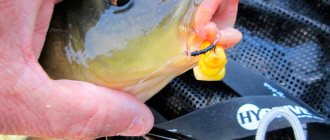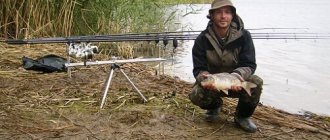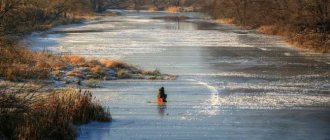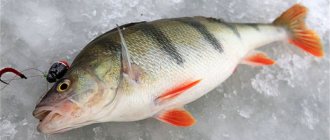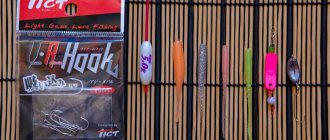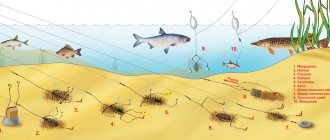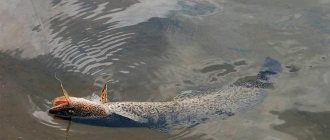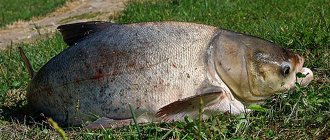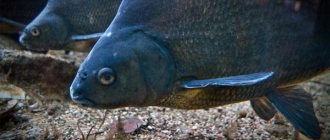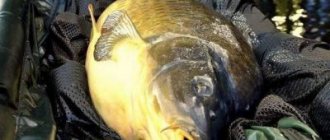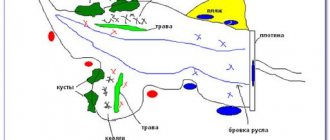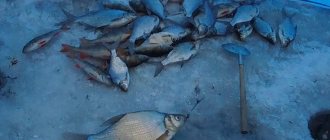Any fish has periods of increased biting that need to be taken advantage of. So carp fishing in September promises trophies and seems even more promising than in summer. Yes, you need to take into account a number of nuances, choose equipment, place, bait, but if you do everything correctly, you will have every chance of catching a good specimen and updating the record.
That’s why we want to describe in detail how to catch carp in September. Summarizing all the experience gained, in this review we will consider every important point regarding the choice of time, place, lines, bait and other factors that can bring your trophy catch closer.
September carp
There is a long, cold winter ahead and the fish, sensing its approach, begin to actively feed, fattening up and preparing for a long winter hibernation. Among all the trophies available for fishing in September, it is worth highlighting carp, whose bite increases. This domesticated form of carp is a solid catch!
In addition, the right time is coming for carp fishing - carp begin to eat in September, which will last until the first frost. So, pack your gear and go to the pond - carp fishing in September is considered one of the most productive. Just don’t forget animal bait - due to lower water temperatures, carp begin to peck more on live bait.
Habitat
Carp has southern roots. In cold water it practically does not feed and moves very little. After winter, somewhere in early May, this fish in the middle zone begins its active life. People say that before the lilac blooms and the mountain ash ripens, there is no point in catching carp
. This fish sometimes jumps out of the water. But this is done not only during critical situations, but also, for example, before feeding and when trying to escape from the seine. By such jumps you can accurately determine where the next feeding will be. Carp almost always live on a grassy lake.
Where to catch carp in September - carp fishing spots
Carp should be looked for in reservoirs with a muddy bottom; occasionally carp can be found on a hard bottom, but never on a rocky one. Keep in mind that if crucian carp lives in a reservoir, then there is a high probability that you can also find carp there. At the same time, always remember that carp is an artificial form of carp and can be found more often on paid reservoirs than on publicly accessible ones.
What is special about carp fishing in September?
Beginning fishermen should know that in September large carp go deeper. This is due to the fact that the water becomes cleaner and transmits better daylight and sunlight. But carp don’t really like it. It’s not for nothing that they prefer muddy bodies of water.
Accordingly, carp fishing in September will be more successful if you look for carp at depth - catch it in the pits. Please note that the fish may not show any activity, may not bite, or hide in deep holes. However, if you study the bottom topography well, in particular, know the location of large holes, you will have a good chance of catching September carp. And even if it was still not possible to catch a carp, the fisherman can count on catching a predator (pike or pike perch), which often guard the winter quarters of small fish.
Where to look for carp
A reservoir with a muddy (but not rocky) bottom is the habitat of your possible trophy fish. He loves to rummage in the ground, looking for food. Well, he really likes muddy water, because he can hide in it if necessary.
Pits are also promising places to find carp, because in September they swim to the depths. Plus, he is looking for a place to hide and survive the winter season, and edges and riffles are great for this. And on clear and fine September days you can look for carp in the thickets - when the water is warm, it still swims to the shore. So there are plenty of promising points - explore the bottom, recognize its topography and start casting.
When to catch carp in September - fishing time and weather
At the beginning of autumn, when it has not yet become very cold, carp fishing is more successful at dawn. Experienced fishermen claim that you can start carp fishing in September almost from the very early morning. The further you get towards the end of the month, the more carp fishing in September shifts towards midday and practically subsides with the evening cold snaps. The evening bite is always much worse than the morning bite, and smaller carp take the bait at this time.
Please note that carp love calm days - in calm weather, carp can take almost any bait. And, conversely, on windy and rainy days the fish prefers to hide at the bottom.
What to feed?
Despite the colder water at the beginning of autumn, bait for carp is also necessary. But the composition of the mixture and its flavoring are gradually changing:
- the composition becomes poorer;
- soil is added to the mixture;
- bait components are added.
Maggots and bloodworms in the bait mixture attract fish better.
The flavoring of bait mixtures also changes over time. If at the beginning of the month sweet and fruity aromas are still active, then by the end of the month they gradually switch to spicy and meaty attractants:
- anise;
- makukha;
- dill;
- shrimp;
- maggot;
- garlic.
By the way! These aromas work well in the fall and on crucian carp - the eternal companion of carp in our ponds. Often, in the absence of carp bites, it is possible to catch a solid catch of weighty individuals of this species.
What to catch carp with in September - groundbait and bait
Bait for carp fishing in September does not play a special role. Although some fishermen recommend feeding the fishing spot for several days, arguing that carp, like a pig, loves to eat and will not refuse the offered bait. However, when fishing for carp in September, the angler should pay the main attention to properly selected bait.
Carp fishing in September can be carried out with the following baits: maggots, large earthworms, crayfish meat, bread pellets, boilies, oatmeal porridge with sugar and peanut or cinnamon flavorings, shellfish.
How to catch carp in September - gear for carp fishing
Cooling water becomes more transparent, which carp really don’t like. Therefore, proper camouflage of the fisherman and equipment is of great importance when fishing for carp in September.
Carp fishing in September can be done with both bottom and regular float rods. Moreover, the float should not be too bright and noticeable so as not to alarm the fish.
The fishing line should also be chosen taking into account maximum invisibility in the water. Fluorocarbon fishing line with a refractive index equal to water is ideal for this purpose. Such a fishing line will be absolutely invisible in river water.
For catching large carp, it is best to use braided fishing line, because... It will be quite problematic to pull out such a fish on a regular fishing line. When using a regular thick fishing line, the fish may notice it and leave, but with a soft “braid” this problem can be easily avoided. But here we must not forget that braided fishing lines practically do not stretch, so all the angler’s movements are immediately transferred to the hook.
Catching carp in the fall
Photo: Anatoly Mailkov.
For some reason, the opinion persists that in cold water, heat-loving fish stop feeding, move to the deepest places and lie down there for the winter.
And the story continues to exist that crucian carp generally buries itself in the bottom silt, where it goes into suspended animation for the entire winter.
This is generally absurd, since any living organism needs oxygen at least in minimal quantities, and in muddy deposits there is none at all.
But the seasonal behavior of any fish is connected not so much with the temperature of the water, but with the entire complex of living conditions that have developed in a particular body of water.
In addition, the habits of various fish, including carp and crucian carp, are largely determined by age and size.
But about everything in order and in contrast to the above opinions, which probably arose and took root under the influence of old fishing literature.
Here you need to understand that fifty to a hundred years ago the climate of the middle zone was much harsher than it is now, and they did not deeply study the behavior of fish, often passing off hypotheses, rumors and assumptions as truth, because there was apparently a lack of objective information .
In addition, much of the information related to the lifestyle of red or golden crucian carp, as well as carp, raised on a fish farm on free food served on a schedule, while the fish were almost not accustomed to searching for and consuming natural food that varied in different seasons.
Currently, the situation in many reservoirs is such that you can almost no longer see golden crucian carp in them - it has been almost completely replaced by silver crucian carp, which leads an active life all year round, and therefore does not stop feeding.
This is especially evident in those ponds, lakes and quarries where, even in relatively harsh winters, a normal oxygen regime is maintained, allowing not only crucian carp, which are unpretentious in this regard, to survive, but also roach, perch, pike, and other fish that are sensitive to water quality, including including the “wild” carp, which was released into the wild.
It is in such reservoirs, which, as a rule, are distinguished by significant depths, flow to varying degrees or the presence of a large number of springs, and, moreover, densely populated with fish of various species, crucian carp and carp retain sufficient mobility until freeze-up.
Read the material “Remembering the Golden Autumn”
This relatively high activity is necessary for them to search for food. This is due to the fact that here they experience constant competition from fellow animals and numerous small items and do not have time to accumulate the required amount of fat. Therefore, in cold water they often consume food that is unusual for them, in particular, sometimes they become ardent predators, massively exterminating fry or the small fish that predominate in the reservoir, for example, verkhovka, gudgeon or bitterling.
This circumstance must be taken into account by the fisherman when selecting effective attachments or baits for catching crucian carp and crucian carp in late autumn, while taking into account the repeatedly proven fact that the larger the fish, the more prone it is to a predatory lifestyle.
| Photo: Anatoly Mailkov. |
And in this regard, we can cite many cases from our own fishing practice and information from modern publications, when on one of the ponds in the late autumn of “wild” carp, which had reached a weight of only two kilograms, it was possible to successfully catch with a fishing rod exclusively on the top - live or dead , but fresh, just mined in this reservoir.
And in the southern regions, where numerous ponds abound not only with carp and crucian carp, but also carp, grass carp, and silver carp, it has become common practice in cold water to effectively seduce large fish by placing compact pieces of cut gudgeon on the hook. By the way, almost all predators and, apparently, not only them, have a clear predilection for it in cold water.
In addition, modern fishing techniques with feeder gear involve the use of special multi-component boilies as bait.
Read the material “The influence of smell on biting”
So, catching large carp in cold water often gives excellent results if quite a lot of minced meat is added to the mixture for homemade boilies, which, of course, indicates the autumn orientation of the fish towards food of animal origin.
Apparently, when the temperature of the habitat decreases below a certain threshold value for each fish, it can no longer quickly obtain the necessary energy from plant food, which takes a long time to be absorbed by a cold-blooded organism. But any living creature consumed by fish under the same conditions gives more energy per unit of its own weight and decomposes in the digestive organs in less time.
Where there are a lot of carp and it makes sense to engage in special autumn fishing, when the water has cooled, they gather in fairly deep areas of the reservoir, where the water is somewhat warmer than in shallow waters.
Therefore, in the fall, for fishing, it is better to choose ponds that are large in size, characterized by steep changes in bottom relief, which ensures the formation of zones of local concentration of fish.
Here, somewhere closer to the middle of the day, the carp begins to actively dig into the bottom sediments, looking for bloodworms and picking up other animal food, and, naturally, it is then easy to seduce with a worm, a bunch of bloodworms and maggots, or a “sandwich” of them on a hook.
As for the gear, a float rod with rings and a reel, an extremely light, rough bottom with a feeder, and a sensitive pickerel with just a weight and one or two leashes are suitable - the tackle is not so important, the main thing is to accurately hit the fish site.
The success of fishing will also be facilitated by light bait, thrown into the right place long before the fish come out to feed - it is now designed not to attract carp from somewhere far away, which is almost useless in the fall, but only to encourage it to search for food and move.
Read the material “A long fight with carp - the wife’s view”
It is important not to overdo it with flavorings in bait, which is unacceptable in clean autumn water. By the way, it has been noticed that carp and crucian carp are very well attracted by soil dug up in the meadow and added in fair quantities to the bait.
| Photo: Anatoly Mailkov. |
PREDATORY HABITS
If we move a little away from the traditional fishing of crucian carp and crucian carp with the usual gear, then we should touch on the facts of accidental and even purposeful catching of these fish with a spinning rod using artificial bait when hunting for pike or perch in the autumn.
An experienced fisherman can always understand who owns the neat “pokes” that suddenly begin in some place in the reservoir, unusual for common predators. In this case, you should not throw a position from which there seems to be contact with the fish, but it does not sit on the hook, but it is better to try to experiment both with the selection of bait and with the method of its animation.
Read the material “Frogs are an excellent animal bait”
As a rule, large carp and even crucian carp can still be lured into the right bite if you use an extremely compact imitation of minimal weight, which, while playing, falls to the bottom for quite a long time after casting - it is at this moment, which is called “flight”, that there are many bites carp
Then, when the bait has reached the bottom, its retrieval begins, usually in steps with a high rise at each stage and a time-consuming drop down, which is precisely what makes it possible to keep its weight to a minimum.
And it doesn’t matter what type of imitation is used - it can be the smallest spinner, combined in front with a “eared” weight (jig-spinner), or a suitable-sized twister or vibrotail, or a narrow foam fish.
In this case, the technical execution of step-by-step wiring presupposes that the pace of bait delivery is slowed to the limit, since carp and crucian carp in cold water are very leisurely and confidently grab only what, as they say, fits into the mouth itself.
The most important technique in this technique is to briefly drag the bait along the bottom, forming a cloudy trail behind it, before it rises into the water column on the next “step.”
Such behavior of potential “food” most often leads to a confident “pressure” by carp or crucian carp, when the bite is felt like a soft pull or a moving hook. Then, when the fish hits the hook, a powerful pull will follow, especially if it concerns carp, so the fisherman needs to be prepared and adjust the friction brake on the reel in advance.
Otherwise, on the most dangerous first throw, the fish will either break the thin line that is needed for a small bait, or bend or break the small hook corresponding to the bait, and may also tear its lip - in any case, an enviable and rare trophy will be lost.
If you managed to parry the first jerk, then you don’t have to rush too much and don’t force the fight when there is no snag nearby.
Read the material “Huge boars of Turkestan”
It is better not to take the carp by force, since it has sensitive and painful lips, so more rapid throws will follow, which are always summed up by the impact on all elements of the tackle and can lead to an offensive loss of fish at the final stage.
Anatoly Mailkov September 22, 2021 at 02:27 pm
Catching carp with a float rod
Using a float rod when fishing for carp also gives good results. When fishing for carp, you need to choose a very durable fishing rod (carbon or composite). As practice shows, when large carp are biting, rod breakage is not such a rare case. When fishing for carp, the recommended line diameter is 0.35–0.40 mm.
With expensive and high-quality fishing line, you can use a diameter of 0.30 mm, but not thinner.
It is advisable to use a float that is large enough, but not brightly colored, so as not to scare the wary carp. It is also advisable to use leashes 20–30 cm long, for which the fishing line used is 0.03–0.05 mm thinner compared to the main one.
The most successful hooks are hooks No. 3–4.
There is no point in using large hooks, since in this case the carp, out of caution, may not take the bait on such a hook. Peas have shown themselves to be excellent as bait when fishing with a fishing rod. To prepare it, in addition to peas and water, vanillin and a sugar substitute (for example, sucrasite) are used, which ensures greater preservation of peas than sugar.
In addition, before soaking the peas in water, you can add various flavors, not only “sweet”, but also “meat” - crab, shrimp, bloodworm, maggot. However, you shouldn't mix too many scents together, as this can have the opposite effect. Peas prepared in this way can replace a large variety of baits. In this case, the preferences of carp must be clarified experimentally.
Using peas as bait also gives good results, since due to their large size they are not consumed by small fish. It is useful to add animal components to peas - worms, maggots. Among other things, a very important piece of equipment when fishing for carp with a fishing rod is a net, which will greatly help to remove the fish from the water without breaking the fishing line or breaking the rod.
Fishing for carp on a feeder
Based on the fact that the feeder is a bottom tackle, the greatest effectiveness of its use is observed when fishing significant depths in the bottom and holes of reservoirs with little current, at a great distance from the shore further than 20 meters, where fishing with a float will no longer work.
When fishing for carp, durable feeder rods (carbon or composite) are used, which make it possible to cast heavy feeders over fairly long distances. In this case, a spinning reel and a strong braided fishing line of small diameter are used for ease of casting.
To place additional bait when using a feeder, special high-capacity feeders are used, which are thrown to the fishing point using a powerful feeder rod. The most successful bait is flavored boilies of various sizes and scents. The best results are provided by: vanilla strawberry peach.
Adding sweet ingredients also gives good results. However, to use boilies when fishing with a feeder, you need to use special equipment. If problems arise with this, you can use pearl barley, corn or boiled potatoes as bait. Carp partly have a sweet tooth, so they are attracted to various baits with the addition of sweet ingredients. This factor is successfully used by fishermen all over the world.
To fish with boilies, you need to use special equipment, which not all anglers can do. For beginners, it is best to use sweet corn, pearl barley, or boiled potatoes to catch carp on a feeder. Gardner feeder rig is also very popular for feeder carp fishing, as it allows you to fish even on muddy ground.
Andrey Shalygin
Read expert opinions
About the features of fishing described in the article
carp
About the features of the types of fishing described in the article
float fishing
bottom fishing
